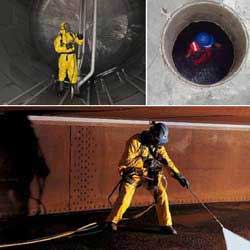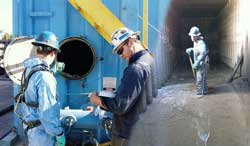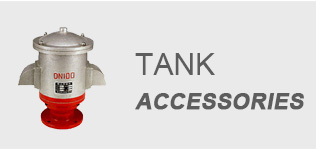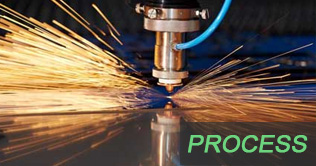How Much do You Know about Oil Tank Cleaning Procedure?
During the long storage process of oil tank, mechanical impurities, sand, soil, heavy metal salts, paraffin, asphalt as well as other heavy oil component contained in the oil product will settle naturally, because of the specific gravity difference. These components will accumulate in the bottom of oil tank, formed a thick and black gelatinous material layer, which is sediment of storage tank. The sediment will increase with the continuous increasing time of oil storage and transportation, over time, influenced the storage and transportation of storage tank, so that it is important to clean the oil tank regularly, which is also required by production safety.

There are four methods for oil tank cleaning procedure: dry cleaning, wet cleaning, steam cleaning, and chemical cleaning. Now let’s talk about oil tank cleaning procedure for each of these four methods.
Oil tank cleaning procedure for dry cleaning method
- Exclude oil stored in the storage tank.
- Ventilate the oil tank to exclude the gas and oil in the tank; and measure the oil tank to ensure that the concentration of oil and gas within a safe range.
- Oil tank cleaning worker enter the tank to clean oil, water, and other sediment.
- Dry cleaning with sawdust
- Remove the sawdust, then remove the local corrosion with copper tools.
- Clean thoroughly with mop.
- Quality inspection and acceptance for dry cleaning.
Oil tank cleaning procedure for dry cleaning method

- Exclude oil stored in the storage tank.
- Ventilate the oil tank to exclude the gas and oil in the tank; and measure the oil tank to ensure that the concentration of oil and gas within a safe range.
- Oil tank cleaning worker enter the tank to clean oil, water, and other sediment.
- Wash the oil and corrosion in the storage tank with 290~490kpa high pressure water.
- Exclude the washing sewage as soon as possible, and clean up the tank by mop.
- Ventilate with dry wind for dehumidification.
- Remove the local corrosion with copper tools.
- Quality inspection and acceptance of wet cleaning.
Oil tank cleaning procedure for steam cleaning method
- Exclude oil stored in the storage tank.
- Ventilate the oil tank to exclude the gas and oil in the tank; and measure the oil tank to ensure that the concentration of oil and gas within a safe range.
- Oil tank cleaning worker enter the tank to clean oil, water, and other sediment.
- Clean the oil tank with steam, which is mainly used to clean viscous oil tank.
- Wash the oil with high pressure water, exclude the sewage as soon as possible, dry clean the oil tank with sawdust.
- Remove the sawdust, then remove the local corrosion with copper tools.
- Clean thoroughly with mop.
- Quality inspection and acceptance for dry cleaning.
Oil tank cleaning procedure for chemical cleaning method
- Exclude oil stored in the storage tank.
- Ventilate the oil tank to exclude the gas and oil in the tank; and measure the oil tank to ensure that the concentration of oil and gas within a safe range.
- Oil tank cleaning worker enter the tank to clean oil, water, and other sediment.
- Wash the system and equipment by tank cleaning machine.
- Pickling and derusting for 90~120min.
- Remove acid liquid and wash the tank with clean water for 20min, natural washing liquid is appropriate.
- Exclude the sewage, do passivation treatment for two times, the first time is 3min, and the twice is about 8min.
- After passivation 5~10min, wash the tank for 8~12min with 290kpa pressure water.
- Exclude the washing sewage as soon as possible, and clean up the tank by mop.
- Ventilate with dry wind for dehumidification.
- Quality inspection and acceptance for dry cleaning.
Safety precautions of oil tank cleaning procedure

Oil tank cleaning is a relative dangerous operation in the tank, because the oil vapor is not only flammable, explosive, but also toxic. Therefore, oil tank cleaning procedure must be strictly abide by the following safety requirements.
- Open the manhole, inspect the oil quality in the tank bottom, determine the oil removal and treatment plan.
- Cleaning workers must wear work clothes, work shoes, working gloves, wear gas masks, as well as signal rope and belt. Staying time should not be too long, generally suitable for 15~20min, shift work. In addition, there must be medical personnel on duty on the scene.
- Clean the residual oil sewage by broom or wooden tools, prohibit the use of iron and steel tools.
- Must adopt effective ventilation.
Oil tank cleaning standard
- After cleaning the oil tank is required no rust, no impurities, no water, no grease.
- After oil tank cleaning is completed, the two sides should be responsible for the quality inspection and acceptance, and sign the acceptance report.
- After acceptance of the tank, immediately close the manhole, connect pipe, and restore to its original state.
- After the end of oil tank cleaning procedure, the site should be cleaned thoroughly according to regulations, and record it. Effectively ensure safe construction, civilized construction.



